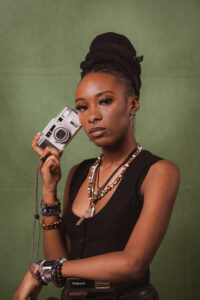Happy Black History Month! Black and queer folk have existed for centuries across continents, cultures, and in a vast number of spaces. Historically, Black people have been forced out of spaces and in turn created our own spaces and practices where we could feel safe and free. As a result, we have formed a sense of resilience, showing the world that we are just as valid in our own skin. The same is true for Black queer folk, being part of a marginalized community as well.
During the times when our people were being enslaved, for example, a number of practices were stripped away leading Black people to get creative in terms of self-expression, third spaces, and cultural practices. A prime example of this in more recent times within the Black queer community is the curation of the ballroom scene by Black folk. Created as a safe space for Black queers to express themselves openly through art, dance and community, the ballroom scene has evolved into a space where queer people of all demographics are welcomed and can go to let go and be free without
judgement. This is just one example of the many Black and queer-specific practices, spaces and subcultures that we are familiar with today. We found a way to create our own, and turn it into something beautiful.

Black people as a whole have always been known to be resilient. With the rise of the Black Lives Matter movement that challenged the notion that Black lives were disposable at the hands of the police. The objective was to spread the message that Black lives are important and valuable. This movement included Black queer and trans lives as well. With higher rates of violence and harm against members of the queer community as a whole, it is important to remember that people who are both Black and queer have even more challenges to face in terms of safety. Black Lives Matter applies to ALL Black lives – including Black queer and trans people. It gives Black queers a reason to fight back, and to stand up to the systems that try to oppress us. The movement drives home the idea that Black queers are important too, and should have just as much of a right to leading a long, safe life as the next member of the Black
community. We can take pride in the fact that we exist as both Black and queer.
It is very common for culture to reflect one’s personal style, lifestyle choices, and overall identity. This is especially true for members of the Black and queer communities. As mentioned previously, both communities have historically faced challenges in terms of having to assimilate in order for individuals to be accepted by their respective communities – this can include everything from societal norms to personal aesthetic. However, whenever a Black and queer person chooses to live as their authentic self, this
idea is gracefully challenged.

A prime example of this is seen among Black queers when building families. The idea of a heteronormative family structure is removed and a new idea is presented. We’ve seen beautiful family structures among Black queer families that otherwise would not exist had those individuals not made a conscious decision to live in their truth, and challenge the societal and cultural norms at hand. There’s certainly a level of beauty that comes hand in hand with strength and courage to live as your full, authentic self.
Black culture is commonly the blueprint for a number of different factors in terms of influence on a large scale. We’ve seen this through media, music, art & fashion, food, and a plethora of other areas. For myself personally,
It defines me down to my physical appearance, as well as the very essence of my being. It’s in the way I carry myself, the way I choose to present, and how I navigate life as a whole. I believe that queer people, having existed for as long as we have, are truly sacred. The same goes for Black folk. Black queers have always existed, and have always been valid. By choosing to live in my truth, I’m choosing not only to honour myself but to honour those who came before me. Those who fought for people like me to even have the opportunity to live life freely and go through society as my true self. To be Black and queer is to be powerful, to be strong, and to be beautiful – and I wouldn’t have it any other way. The societal expectation for women, and particularly trans women, to conform to passive or submissive roles clashes with the reality of my assertive nature. The intersection of race, gender, and transgender identity creates a unique set of challenges as society grapples with preconceived notions about how individuals should express themselves.

Indica Cornish (they/them), is a 24-year-old photographer & creative based in Toronto, ON. They’ve worked with multiple notable clients, such as Sprite, Adidas and Live Nation to name a few. After shooting & creating for around 5 years, they enjoy doing creative projects that help to better both the creative and queer communities in the city.

